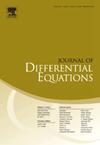光滑库普曼特征函数
IF 2.3
2区 数学
Q1 MATHEMATICS
引用次数: 0
摘要
任何动力系统,无论是由微分方程生成的,还是由流形上的变换映射生成的,都会在泛函空间上产生动力学。函数空间的选择可能不同,但诱导的动力学总是线性的,并由库普曼算子编码。库普曼算子的特征函数在动力学研究中具有极其重要的意义。它们提供了动力学的混合和非混合组件之间的明确区分,并且还揭示了嵌入的总旋转。通常选择的函数空间是L2,一类平方可积函数。L2中特征函数的一个基本问题是它们通常是极端不连续的,特别是当系统是混沌的时候。有一些称为斜积动力学的原型系统,其中L2库普曼本征函数也是光滑的。本文表明,在遍历系统的一般假设下,这些原型例子是唯一的可能。此外,光滑特征函数还可以用于创建变量的变化,该变量的变化也可以显式地表征弱混合分量。本文章由计算机程序翻译,如有差异,请以英文原文为准。
Smooth Koopman eigenfunctions
Any dynamical system, whether it is generated by a differential equation or a transformation map on a manifold, induces a dynamics on functional-spaces. The choice of functional-space may vary, but the induced dynamics is always linear, and codified by the Koopman operator. The eigenfunctions of the Koopman operator are of extreme importance in the study of the dynamics. They provide a clear distinction between the mixing and non-mixing components of the dynamics, and also reveal embedded toral rotations. The usual choice of functional-space is , a class of square integrable functions. A fundamental problem with eigenfunctions in is that they are often extremely discontinuous, particularly if the system is chaotic. There are some prototypical systems called skew-product dynamics in which Koopman eigenfunctions are also smooth. The article shows that under general assumptions on an ergodic system, these prototypical examples are the only possibility. Moreover, the smooth eigenfunctions can be used to create a change of variables which explicitly characterizes the weakly mixing component too.
求助全文
通过发布文献求助,成功后即可免费获取论文全文。
去求助
来源期刊
CiteScore
4.40
自引率
8.30%
发文量
543
审稿时长
9 months
期刊介绍:
The Journal of Differential Equations is concerned with the theory and the application of differential equations. The articles published are addressed not only to mathematicians but also to those engineers, physicists, and other scientists for whom differential equations are valuable research tools.
Research Areas Include:
• Mathematical control theory
• Ordinary differential equations
• Partial differential equations
• Stochastic differential equations
• Topological dynamics
• Related topics

 求助内容:
求助内容: 应助结果提醒方式:
应助结果提醒方式:


